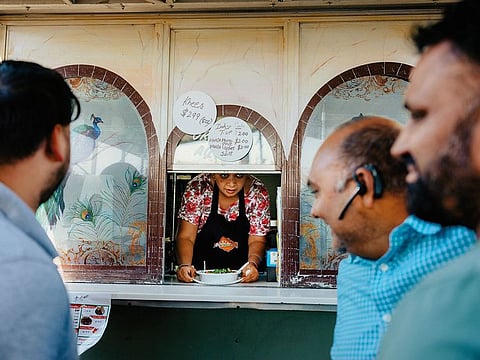A taste of home for California’s Punjabi truck drivers
All the food is ideal for drivers who might find themselves craving something familiar

BAKERSFIELD, California: The rotis were flawless, king-size rounds. Each one was thin and even, freckled with char and shimmering. The dough had been rolled and cooked to order, so the rotis came out hot and supple, stacked on a paper plate alongside deli containers of dal and a few plastic spoons.
It was a modest-looking set-up. But if you were tired and bleary-eyed from the road, like so many of the drivers who parked their big rigs in the lot behind Punjabi Dhaba, it was a luxurious break from fast-food chains and gas-station snacks.
Next to a truck wash and a repair shop, Punjabi Dhaba is reminiscent of dhabas in India and Pakistan, the absolutely-no-frills roadside restaurants that cater to truckers and others passing through with cheap, hearty dishes of chole — chickpeas soaked in a gingery tomato sauce — and slick parathas.
In the United States, trucking has traditionally been dominated by white men, but in California, home to well over 100,000 drivers, immigrants with roots in the Indian state of Punjab are helping to alleviate a national shortage of drivers. The American Trucking Associations estimated a shortage of about 50,000 drivers last year — a number that keeps growing as truckers age out and retire.
In the process, the Punjabi population is expanding the definition of what it means to be a trucker in California, as well as changing the flavours of the great American truck stop.
Punjabi Dhaba caters to the growing community of Punjabi truckers with ample space to park semi trucks and a stack of free Punjabi Trucking magazines, filled with bilingual articles and ads. (A green-eyed cat comes around and naps on this occasionally.)
The kitchen is run by several fast-moving, masterly women who chat among themselves in Punjabi, as well as to their clientele, while handing out sweet, freshly boiled chai in styrofoam cups.
Most of the dishes are vegetarian, but they’re still road-stop fare: thick and rich with sauces of reduced tomato and cream, and generously seasoned and spiced. The butter chicken packs heat and smoke — it’s made from the dark thigh meat and cooked in a clay tandoor. All the food is ideal for drivers who might find themselves craving something familiar on the road, away from home for weeks at a time, moving freight up and down the highways.
For over a century, Bakersfield and its tastes have grown alongside its immigrant workforce. When Basque immigrants came to the region in the late 1800s, to farm sheep and grain, boarding houses sprang up near the train depot, along with kitchens that specialised in comfort food for shepherds from the Pyrenees.
That culinary legacy survives in a handful of Eastside bakeries and restaurants, including Noriega Hotel, which serves an early breakfast of fried eggs with chistorra — a smoky sausage, dyed red with paprika — and dinner with sides of beans and pickled tongue.
Punjabi Dhaba, along with the city’s Sikh temples and Indian grocery stories, points to the influence of a more recent wave of immigration to Bakersfield.
A husband-and-wife team, Balvinder Singh Saini and Mansi Tiwari, took over Punjabi Dhaba in 2016, a former Mexican food truck. The menu is small, and Saini, a former trucker, along with Tiwari and their relatives, cook each dish from scratch.
In India and Pakistan, dhabas aren’t only for the truckers who frequent them.
College students visit them late, on the way home after a party, and families stop in on road trips. It’s similar at Punjabi Dhaba, where local families with small children and truckers passing through all sit together, ripping rotis, scooping up mouthfuls of paneer and chole, and slurping hot tea.
Everything is available to go, which means you can carry your rustling plastic bag through the parking lot, and back to your car. But the best way to enjoy Punjabi Dhaba is to take a break from the road and stay awhile.
In a dusty, industrial parcel, Saini and Tiwari have built a lush, shady retreat and surrounded it with flowers in blue plastic drums. Their dining area is a few degrees cooler than the parking lot, and prettier, too.
More important, if you order the stuffed paratha — and you must order the stuffed paratha — a $3 (Dh11) masterpiece that comes, as it should, with a dollop of raita, a few pieces of pickled onion and a single gold foil-wrapped pat of butter, it’s best to take a seat and start on it right away.
For just one, maybe two glorious minutes, the paratha will be hot, almost hot enough to scald the tips of your fingers.
This is the moment to rip it apart, while the paratha is limber with steam, and its char is crisp. Inside, you’ll find a fine, even smear of mashed potato and cauliflower, flecked with onion, ginger and green chili. The road can wait for you, but the paratha cannot.
Sign up for the Daily Briefing
Get the latest news and updates straight to your inbox



